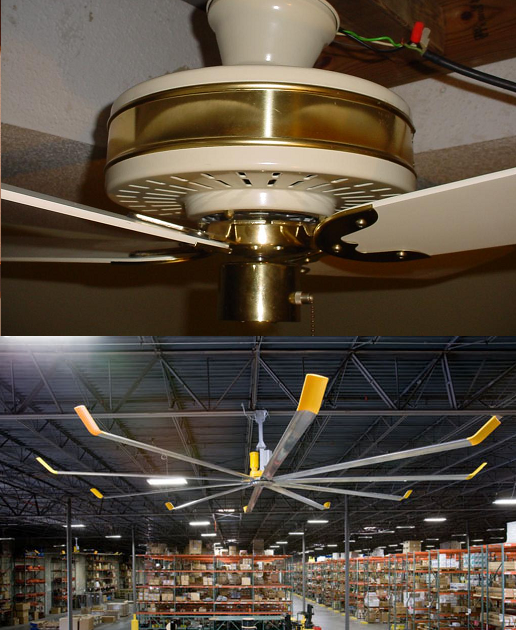Ventilation and Air Distribution
Install Ceiling Fans
What Is It?

Brian E. Hicks
A ceiling fan circulates air throughout a room through a set of rotating fan blades suspended from the ceiling. Contrary to belief, ceiling fans do not cool the rooms they are used in; ceiling fans make the building’s occupants feel cooler because air moves more quickly across skin and accelerates the evaporation of perspiration—much like a breeze provides relief on a hot summer day. In buildings where no air conditioning is available, ceiling fans provide an effective low-cost alternative to installing air conditioning: central air conditioning can cost over 30 times more than running a comparable number of ceiling fans. However, in many large buildings, central air conditioning is already installed or its use is otherwise unavoidable, and the installation of ceiling fans will serve to supplement rather than replace central air conditioning systems.
Realizing energy savings from ceiling fans in these circumstances can be difficult. When temperatures are not excessively hot, ceiling fans can be used in place of central air conditioning with significant energy savings. If fans and air conditioning are used simultaneously, the use of ceiling fans will result in energy savings only if their use is matched by a corresponding increase in the building’s thermostat and if they are only used when occupants are in the room. While the use of ceiling fans allows for a higher end range of comfortable temperatures (typically around 3⁰F), their use is often not accompanied by a reduction in air conditioning use, resulting in additional overall energy use rather than energy savings. Depending on the existing HVAC system, its energy efficiency, and the degree of control occupants have over temperatures and fans, installation of ceiling fans may or may not be a cost-effective investment for every building.
Benefits
- Ceiling fans provide a cooling effect to building occupants. When ceiling fans are used in place of air conditioning, significant energy savings can be realized. When ceiling fans are used simultaneously with air conditioning, they can allow for an increase in comfortable building temperature, resulting in energy savings.
- Constant air circulation can increase occupant comfort.
Drawbacks
- Ceiling fans do not lower indoor building temperatures.
- Ceiling fans increase overall building energy use when used simultaneously with air conditioning if the thermostat is not raised.
- Ceiling fans are inefficient if left on when building occupants are not in the room.
NEWS
- "Ceiling Fans Have a Purpose," Manning River Times, February 2017
- "12 Brilliant Ways to Keep Your Home Cool without Air Conditioning" Huffington Post, August 2016
RESOURCES
- FacilitiesNet: Operable Windows Can Save Energy
- Green Building Advisor: Using Ceiling Fans To Keep Cool Without AC
- PG&E: Analysis of Standards Options
A SAMPLE OF PROVIDERS
- Wide range of suppliers of standard ceiling fans (see Home Depot or Airdistributor Company)
- Suppliers of fans for larger spaces and commercial/industrial application include Big Ass Fans


